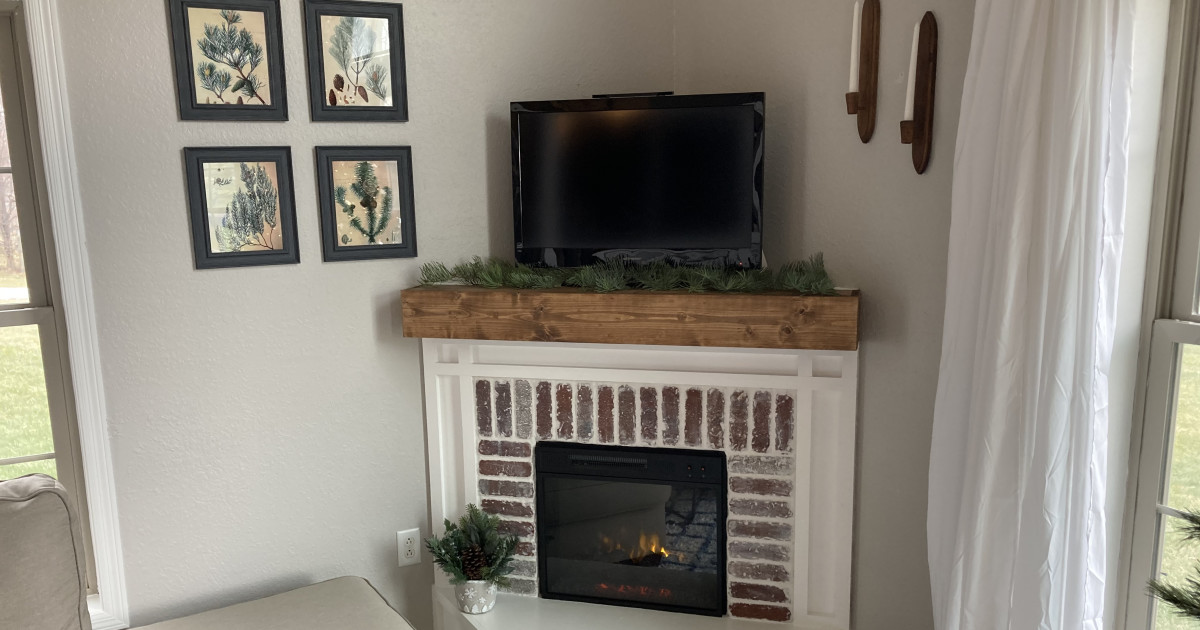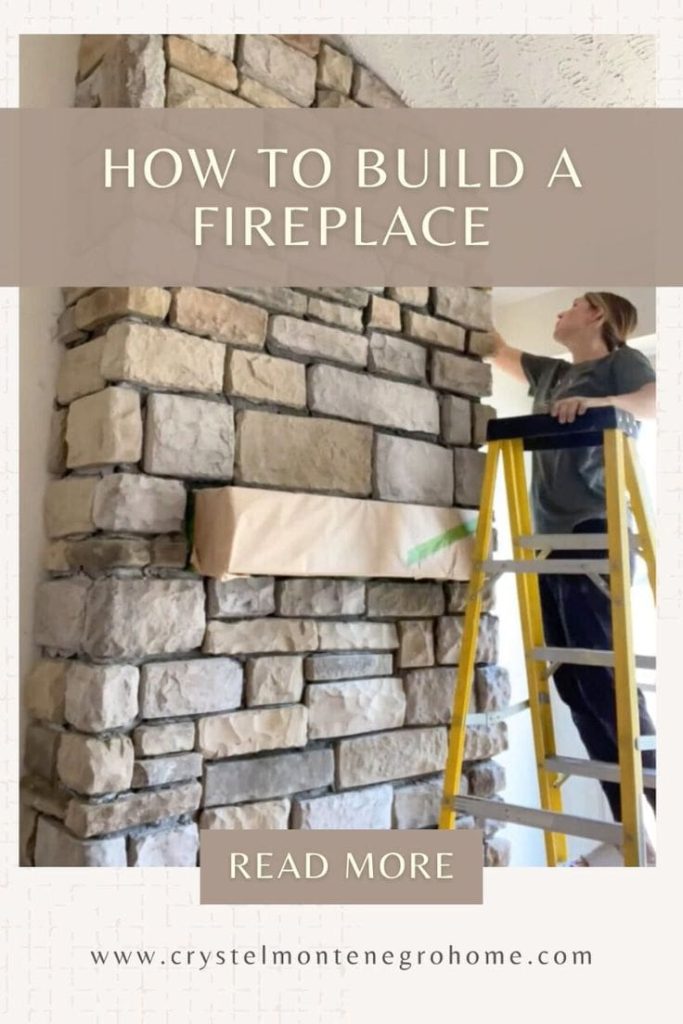Are you ready to transform your living space with a cozy, warm fireplace? Building a fireplace might seem like a big project, but with the right steps, you can create a stunning focal point that brings comfort and charm to your home.
Imagine relaxing by the crackling fire on chilly evenings, knowing you built it yourself. In this guide, you’ll discover simple, clear instructions that make the process easy to follow. Keep reading, and soon you’ll have all the tools and confidence to build a fireplace that’s just right for your space.

Credit: dengarden.com
Choosing The Right Fireplace
Building a fireplace adds warmth and charm to any home. Picking the right fireplace is key to enjoying its benefits.
Think about your needs, style, and space before choosing a fireplace type. This guide helps you make a good choice.
Types Of Fireplaces
Fireplaces come in many types. Each type has its own look and way of working.
- Wood-burning fireplaces use real wood logs for heat and sound.
- Gas fireplaces run on natural gas or propane for easy use.
- Electric fireplaces plug in and use heat and light effects.
- Pellet stoves burn compressed wood pellets for heat.
- Outdoor fireplaces create a cozy spot outside your home.
Materials To Consider
Materials affect how your fireplace looks and lasts. Pick strong and safe materials.
- Brick is classic and holds heat well.
- Stone gives a natural and sturdy look.
- Metal frames can be sleek and modern.
- Concrete is durable and can be shaped easily.
- Tile adds color and pattern to your fireplace.
Location Selection
Where you place your fireplace matters for safety and comfort. Choose a good spot in your home.
Consider space, ventilation, and room use. A living room or family room works well for most fireplaces.
- Keep away from flammable materials.
- Check for proper chimney or vent placement.
- Think about how heat will spread in the room.
- Make sure it fits the room’s size and style.
Planning And Design
Building a fireplace needs careful planning. Good design makes it safe and attractive.
Start by thinking about space, design, and rules to follow. This helps avoid mistakes.
Measuring Space
Measure the area where you want the fireplace. Check width, height, and depth carefully.
Consider nearby walls and furniture. Leave enough room for heat and safety.
- Use a tape measure for accuracy
- Note ceiling height and wall length
- Mark space for the hearth and mantel
- Allow space for walking and furniture
Drafting A Blueprint
Draw a clear plan of your fireplace design. Include all parts and measurements.
The blueprint guides you during building. It helps see how pieces fit together.
- Sketch front and side views
- Label materials and sizes
- Plan chimney or vent location
- Check that design fits the space
Safety Regulations
Follow safety rules for fireplace building. This protects your home and family.
Check local codes for clearances, materials, and installation standards.
- Keep fireplace away from flammable materials
- Use fireproof bricks and mortar
- Install proper chimney or vent
- Ensure smoke can exit safely
- Have a professional inspect the design
Gathering Tools And Materials
Building a fireplace needs the right tools and materials. Gathering them first helps your work go smoothly.
Careful planning can save time and money. It also makes your fireplace safe and strong.
Essential Tools
Use the right tools to build your fireplace safely. These tools help with cutting, measuring, and assembling.
- Trowel for spreading mortar
- Brick hammer for shaping bricks
- Measuring tape for accurate dimensions
- Level to keep surfaces even
- Chalk line for straight guidelines
- Wheelbarrow for mixing mortar
- Gloves and safety glasses for protection
- Masonry saw or angle grinder for cutting bricks
Materials List
Choose strong materials that last. The main parts of a fireplace include bricks, mortar, and fireproof components.
- Fire bricks for the firebox
- Regular bricks for the outer structure
- Masonry mortar to hold bricks together
- Fireproof insulation to protect nearby walls
- Steel lintel to support the opening
- Chimney flue liners for safe smoke exit
- Concrete or stone for the hearth
Budgeting Tips
Set a budget before buying materials. Stick to it to avoid spending too much on your project.
Compare prices and buy only what you need. Renting tools can save money if you do not have them.
- Make a list of all tools and materials
- Check prices at different stores
- Buy quality materials to avoid repairs
- Rent expensive tools you will use once
- Keep extra budget for unexpected costs
Preparing The Site
Building a fireplace starts with preparing the site correctly. This step makes sure your fireplace is safe and lasts a long time.
Focus on clearing the area, meeting foundation needs, and setting a strong base before construction.
Clearing The Area
Remove all plants, debris, and objects from the site. This space should be clean and flat.
Clear at least three feet around the planned fireplace location. This space helps with safe building and use.
- Cut grass and weeds
- Remove rocks and sticks
- Clear any flammable materials
Foundation Requirements
Your fireplace needs a solid foundation to hold its weight. A weak base can cause cracks or collapse.
Use concrete or stone as the foundation. It must be level and strong to support the fireplace structure.
- Foundation depth should be at least 12 inches
- Use reinforced concrete for extra strength
- Make sure the foundation is flat and smooth
Setting A Base
After clearing and laying the foundation, set a base layer. This base helps keep the fireplace stable.
Use gravel or sand to create the base. This layer improves drainage and stops moisture damage.
- Spread 4 to 6 inches of gravel or sand
- Compact the base layer firmly
- Check that the base is level before building
Building The Fireplace Structure
Building a fireplace requires careful planning and strong materials. The structure must be safe and last for many years.
This guide focuses on the main parts of the fireplace structure. These parts include the firebox, chimney, and hearth.
Constructing The Firebox
The firebox is the area where the fire burns. It must be made from heat-resistant materials like firebrick.
Build the firebox with strong mortar to hold bricks in place. Make sure it has a smooth, even surface inside.
- Use firebricks designed for high heat
- Apply heatproof mortar between bricks
- Shape firebox walls with a slight slope
- Leave space for air flow to feed the fire
Assembling The Chimney
The chimney carries smoke out of the house. It must be tall enough to create good airflow and prevent smoke inside.
Build the chimney with strong bricks and mortar. Line it with a metal or clay flue for safety and durability.
- Use fire-resistant bricks for the chimney
- Install a flue liner inside the chimney
- Make the chimney tall enough for good draft
- Seal joints to prevent leaks and cracks
Installing The Hearth
The hearth is the floor area in front of the firebox. It protects the floor from heat and sparks.
Use non-combustible materials like stone or tile for the hearth. It should extend far enough to catch any falling embers.
- Choose fireproof materials like stone or brick
- Make the hearth large enough for safety
- Keep the hearth level and stable
- Seal edges to prevent dirt buildup

Credit: www.youtube.com
Finishing Touches
Finishing your fireplace gives it a polished and complete look. Small details make a big difference in style and function.
These final steps help protect your fireplace and add charm to your living space.
Adding Mantel And Surround
The mantel frames your fireplace and holds decorations. Choose a mantel that fits your room’s style and size.
The surround covers the area around the firebox. It protects walls and adds beauty.
- Use wood, stone, or metal for mantels
- Ensure the mantel is securely fixed to the wall
- Select surrounds that resist heat and match your décor
- Measure carefully before installation
Sealing And Insulating
Sealing gaps around the fireplace stops air leaks. It keeps your home warm and saves energy.
Insulation protects walls from heat damage. It also improves the fireplace’s efficiency.
- Use fire-resistant sealant around edges
- Check for cracks and fill them properly
- Install insulation rated for high temperatures
- Keep sealing materials away from direct flames
Decorative Elements
Decorations add personality to your fireplace. Choose items that match your style and room theme.
Popular decorations include tiles, stone veneers, and artwork above the mantel.
- Use heat-safe paint or tiles for the surround
- Add candles or plants on the mantel
- Display framed photos or mirrors above
- Choose colors that blend with your room
Safety Checks And Maintenance
Building a fireplace is a great project. Keeping it safe and well-maintained is very important. Regular checks help prevent accidents.
Proper care extends the life of your fireplace. It also keeps your home warm and safe.
Inspecting For Leaks
Leaks can cause smoke or fire hazards. Check the chimney and joints carefully for cracks or gaps. Use a flashlight to look inside.
Look for signs of water damage or soot marks. These may show where leaks happen. Fix leaks quickly to keep your fireplace safe.
- Check chimney cap and flashing
- Look for cracks in mortar or bricks
- Inspect seals around doors and vents
- Watch for water stains or rust
Regular Cleaning
Cleaning stops buildup that can block airflow. Remove ashes after every few uses. Clean the chimney at least once a year.
Use a chimney brush to clear soot and creosote. These can catch fire if left inside. Clean glass doors with a special cleaner to keep them clear.
- Remove ashes safely with a metal container
- Brush chimney to clear soot
- Clean glass doors with non-abrasive cleaner
- Check and clean fireplace tools
Troubleshooting Common Issues
Sometimes fireplaces have smoke problems or poor heat. Check that the damper opens fully. Blocked vents can cause smoke to enter the room.
Look for cracks in firebricks or worn-out seals. Replace damaged parts to keep the fireplace working well. If the fire won’t stay lit, dry the wood fully before burning.
- Ensure damper opens and closes properly
- Clear any blockages in vents or chimney
- Replace cracked firebricks or worn seals
- Use dry, seasoned wood for better fires

Credit: www.chimneyworksonline.com
Frequently Asked Questions
What Materials Are Needed To Build A Fireplace?
You need bricks, mortar, firebricks, steel reinforcements, and a chimney liner. Safety gear and tools like trowels and levels are essential. Choosing heat-resistant and durable materials ensures a long-lasting fireplace.
How Long Does It Take To Build A Fireplace?
Building a fireplace typically takes 3 to 5 days. Time depends on design complexity, drying times for mortar, and weather conditions. Planning and preparation can speed up the process.
Can I Build A Fireplace Myself Safely?
Yes, with proper knowledge and safety precautions, DIY fireplace building is possible. Follow building codes, wear protective gear, and use correct materials. If unsure, consult professionals to avoid hazards.
What Is The Best Location For A Fireplace Indoors?
Place your fireplace in a central room for optimal heat distribution. Avoid areas near flammable materials or poor ventilation. Proper placement enhances efficiency and safety.
Conclusion
Building a fireplace takes time and care. Follow each step clearly and safely. Use the right tools and materials for best results. Enjoy the warmth and charm it brings to your home. Remember to check local rules before you start.
A well-built fireplace adds beauty and comfort. Keep safety in mind at all times. Now, you have the basics to create your own cozy space.

